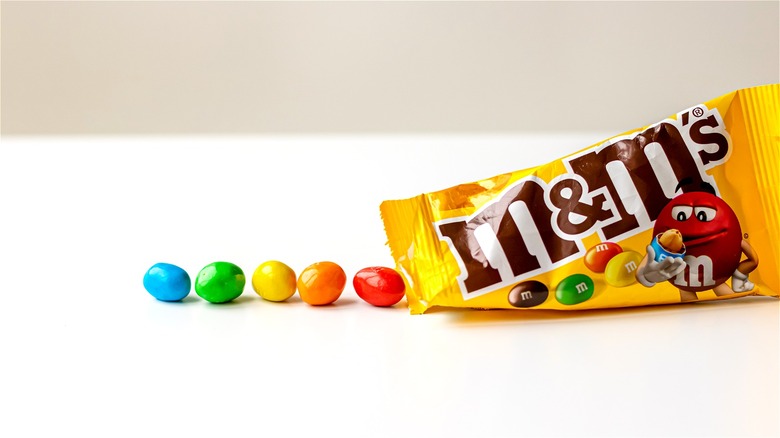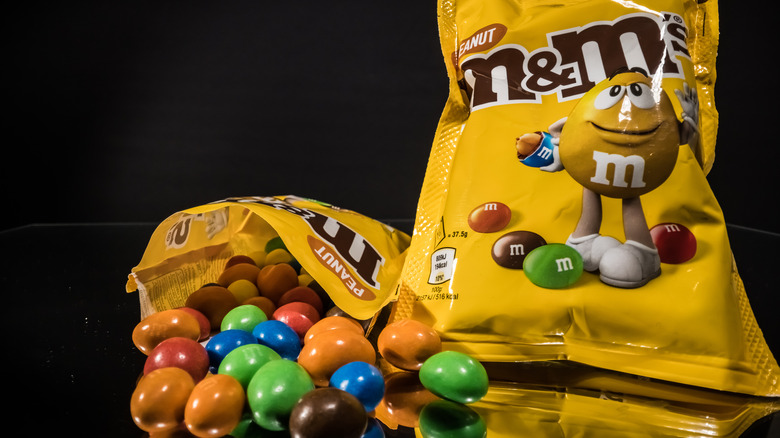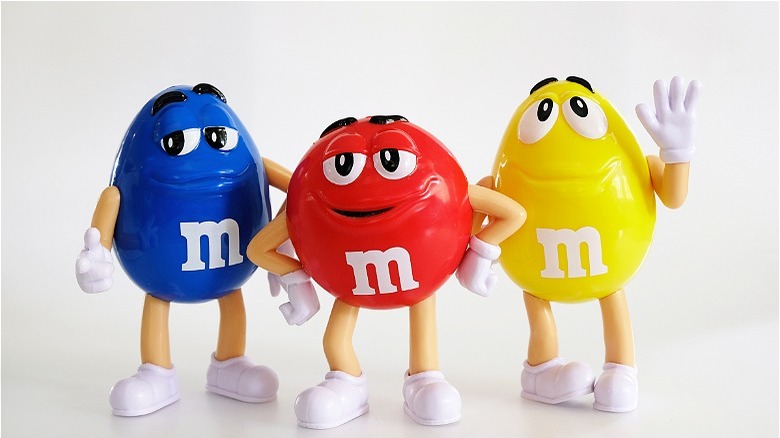Peanut M&M's Used To Look Way Different
There's something about opening a bag of M&M's and seeing all the colors intermixed in that small little package that brings us all back to a childhood memory or two. M&M's are sweet, colorful, and easy to eat, but they weren't initially marketed to everyday consumers. Forrest Mars Sr. saw a golden opportunity to market hard-shelled candy to the U.S. Army in the 1930s. If you ever wondered how M&M's got its name, a simple partnership between two businessmen spawned the iconic double "M" debuting in 1941. Once M&M's span of consumers widened to the general public, a new variety of M&M's was released in 1954: classic peanut M&M's.
Fast-forward to the present, and for many candy lovers, choosing between classic milk chocolate and peanut M&M's is a difficult feat. In fact, based on Google trend search data in 2022 conducted by Shane Co., 14 U.S. states confirmed peanut M&M's stand as their most preferred variety.
Whichever kind you prefer, in present-day America, we know when another holiday approaches based on the ever-changing color palette of these beloved candies. And we all know peanut M&M's stand apart from the original milk chocolate candies based on a nutty addition. Yet, when peanut M&M's first debuted in the 1950s, they were a completely different color from the original milk chocolate candies.
What made peanut M&M's so different from their milk chocolate companions?
M&M's now rank as some of the most popular candies in the U.S. But when peanut M&M's debuted, they weren't as exciting to look at as they are now, thanks to their lack of color. When peanut M&M's came on the scene, they were all just one color: tan.
So, why were peanut M&M's made in only one beige-inspired hue, while regular M&Ms came in a variety of colors? Mars, Incorporated wanted the color to be reflective of the roasted peanuts inside the new M&M variety. This tan-only assortment didn't last, though. In 1960, peanut M&M's saw a boost in the color department, and the nutty chocolate candies were upgraded to tan, green, yellow, and red colors.
According to the McGill Office for Science and Society, red M&M's were temporarily removed from the Mars product line in the mid-'70s due to a public health scare surrounding Red Dye #2 and its potential link to tumor growth in rats. The red M&M's were replaced by orange ones temporarily until red M&M's made a resurgence in 1988.
The colors of M&M's are more important than you think
Colorways have always played a role in marketing decisions surrounding M&M candies. M&M's may have been one of the first candies to offer consumers colorful hard-shelled chocolates, but as the years progressed, the Mars company had to find more creative ways to maintain buyer intrigue. Mars Inc. had already begun paving the way with its red and yellow M&M mascots in advertisements since the 1960s.
The company has also used colors as a way to draw customer interaction and appeal. In the late 1990s, the Mars company cast a worldwide vote for the new M&M color after discontinuing its long-running tan-hued assortment. Then, in the late 1990s, each color of M&M candy was given a face and certain persona for customer relatability. Fast-forward to today, and the Mars candy company continues to upgrade the M&M color characters to reflect current consumer trends. In 2022, M&M's made history with the addition of a brand-new color: purple. This new M&M was released only for specialized promotions regarding acceptance and camaraderie among Americans. The new colorway spurred both positive and negative attention from consumers across the nation.
Beyond the Mars Inc. marketing strategies, fans can customize a colorway of M&M's directly from the M&M's website. However, if your loyalties lie with the peanut variety, you'll either have to settle for a prepackaged mix or a seasonal variety of colors.


